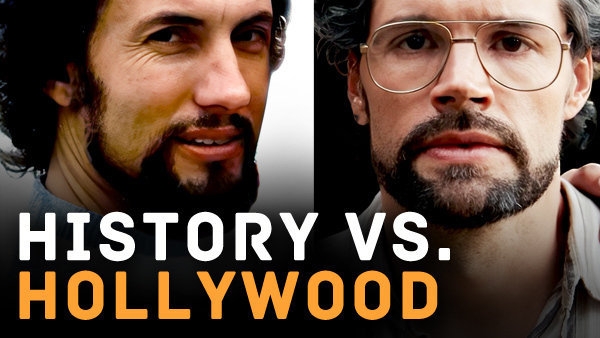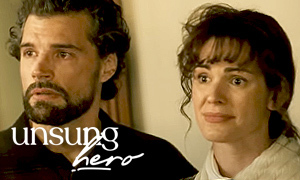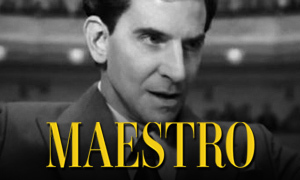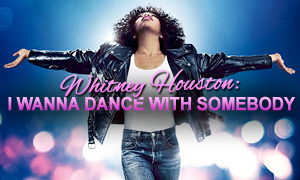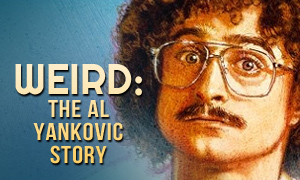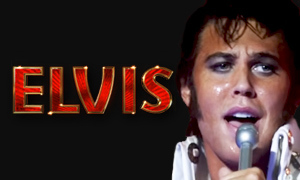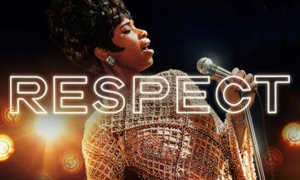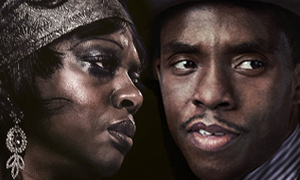Bohemian Rhapsody: History vs. Hollywood
| REEL FACE: | REAL FACE: |
Rami Malek
Born: May 12, 1981 Birthplace: Los Angeles, California, USA | Freddie Mercury
Born: September 5, 1946 Birthplace: Stone Town, Sultanate of Zanzibar Death: November 24, 1991, London, England, UK (Bronchopneumonia as a complication of AIDS) |
Gwilym Lee
Born: November 24, 1983 Birthplace: London, England, UK | Brian May
Born: July 19, 1947 Birthplace: Hampton, London, UK Bio: Queen Guitarist 1970 - Present |
Ben Hardy
Born: January 2, 1991 Birthplace: Bournemouth, Dorset, England, UK | Roger Taylor
Born: July 26, 1949 Birthplace: King's Lynn, Norfolk, England, UK Bio: Queen Drummer 1970 - Present |
Joseph Mazzello
Born: September 21, 1983 Birthplace: Rhinebeck, New York, USA | John Deacon
Born: August 19, 1951 Birthplace: Leicester, England, UK Bio: Queen Bass Guitarist 1971 - 1997 |
Lucy Boynton
Born: January 17, 1994 Birthplace: New York City, New York, USA | Mary Austin
Born: 1951 Birthplace: Fulham, London, UK Bio: Freddie Mercury's One Time Girlfriend and Lifelong Friend |
Aidan Gillen
Born: April 24, 1968 Birthplace: Dublin, Ireland | John Reid
Born: September 9, 1949 Birthplace: Paisley, Renfrewshire, Scotland, UK Bio: Queen's Manager 1975 - 1978 |
Tom Hollander
Born: August 25, 1967 Birthplace: Bristol, England, UK | Jim Beach
Born: March 1942 Birthplace: Gloucester, UK Bio: Queen's Manager 1978 - Present |
Allen Leech
Born: May 18, 1981 Birthplace: Killiney, County Dublin, Ireland | Paul Prenter
Death: August 1991 (complications from AIDS) Bio: Freddie Mercury's Personal Manager 1977 - 1986 |
Aaron McCusker
Born: 1978 Birthplace: Portadown, County Armagh, Northern Ireland, UK | Jim Hutton
Born: January 4, 1949 Birthplace: County Carlow, Ireland Death: January 1, 2010 (lung cancer) Bio: Freddie Mercury's Partner |
Did Freddie Mercury change his name?
Yes. The Bohemian Rhapsody true story reveals that he was born Farrokh Bulsara on September 5, 1946 in Stone Town, Sultanate of Zanzibar (now Tanzania) in eastern Africa. He started going by "Freddie" while attending St. Peter's School, a British-style boarding school near Bombay (now Mumbai). It wasn't until he formed the band Queen in the spring of 1970 that he decided to also change his surname, switching it from "Bulsara" to "Mercury". On Freddie's birth certificate, his parents listed their nationality as "British Indian" and under race they put "Parsi", an ethnic group rooted in Persia.
When did Freddie Mercury arrive in the UK?
Freddie graduated from St. Peters boarding school when he was 16 and returned to his family in Zanzibar. The country gained independence from Britain in December 1963. A month later, the bloody Zanzibar Revolution began, which resulted in the deaths of thousands of Indians and Arabs. The political unrest in the country put Freddie's family in danger and they fled to the United Kingdom. In the following months, Freddie enrolled at Isleworth Polytechnic (now West Thames College), majoring in art. The earliest known footage of Freddie Mercury was taken during his freshman year at the college. He earned a degree in Art and Graphic Design from Ealing Art College in London. In England, Freddie's taste for music expanded from the Indian music he was exposed to growing up, to include the rock and roll music of the day. He was influenced by numerous bands, most notably Elvis Presley, The Who, Jimi Hendrix, Led Zeppelin and The Rolling Stones. He also cited Liza Minnelli as an influence, specifically her Academy Award-winning performance in Cabaret.
When did Freddie Mercury first start performing for paying crowds?
Though he had been in a band called The Hectics while in primary school, his first performance in front of a paying audience was on August 23, 1969 as a vocalist for the band Ibex, who had been looking for a singer. Freddie sung Elvis Presley's "Jailhouse Rock". Future Queen band members Brian May and Roger Taylor were then part of a band named Smile. They knew Freddie and traveled to Liverpool to see him perform with Ibex, even joining Ibex on stage. This marked the first steps toward the birth of Queen. Freddie convinced the other members in Ibex to change the band name to Wreckage. Not long after, the band began to fall apart due to outside obligations by the members, including college, day jobs, and the drummer relocating to America. -Bio Channel
How did Freddie Mercury meet bandmates Brian May and Roger Taylor?
The movie fictionalizes the formation of Queen and makes it much simpler than it was in real life. In the film, Freddie Mercury stumbles into a 1970 performance by Brian May and Roger Taylor's band Smile, which preceded Queen. Mercury meets up with May and Taylor after the show, coincidentally right after their bassist/singer Tim Staffell quits. They're skeptical of Mercury at first, but he wins them over when he delivers an impromptu rendition of their song "Doing Alright".
In answering the question, "How accurate is Bohemian Rhapsody?" we learned that Mercury actually met his future bandmates in less spontaneous fashion at the time he was attending Ealing Art College in London. While there, he befriended Tim Staffell, who was then part of the band Smile with guitarist Brian May and drummer Roger Taylor. May had been attending Imperial College in London at the time and had been working on his PhD in astrophysics. Taylor was indeed studying to become a dentist. Mercury became a fan of the band Smile and got to know May and Taylor. Brian May recalls Mercury hassling them to let him become a member, but they resisted until Tim Staffell left the band in 1970.
Did Freddie Mercury meet girlfriend Mary Austin the same night he joined the band?
No. The Bohemian Rhapsody movie has Freddie meeting his future girlfriend Mary Austin just before his first run-in with Brian May and Roger Taylor, at which point he becomes a member of the band. This is a departure from the true story. In reality, Brian May had briefly dated Mary Austin. Freddie didn't become interested in her until after he was already the lead singer of the band. -RollingStone
Was John Deacon the band's original bass player?
Fact-checking Bohemian Rhapsody confirms that Freddie Mercury was known for having an eye for detail and being a perfectionist. By May 1970, his desire to create the perfect band had contributed to the demise of the first two groups he was in. It was around this time that Brian May and Roger Taylor's band Smile had lost member Tim Staffell, who left to join the band Humpy Bong. Freddie came on board and persuaded the remaining members to change the band's name to Queen. They did recruit John Deacon to play bass, but not until 1971. He wasn't the band's original bassist like in the movie, nor did he play at the first Queen concert in 1970. He was actually the fourth bassist they tried.
Is Mike Myers character, record executive Ray Foster, based on an actual person?
No. Mike Myers (pictured below) portrays Ray Foster, an executive at the EMI record label. The character is fictional. We found no evidence of a real-life Ray Foster while researching the Bohemian Rhapsody true story. At best, he is very loosely based on EMI chief Roy Featherstone, but unlike Foster in the movie, Featherstone was a big fan of Queen. However, he did complain that their song "Bohemian Rhapsody" was too long to be released as a single. That's the only similarity. -Rolling Stone
Was the band aware of the multiple meanings of their name "Queen"?
Yes. "It had a lot of visual potential and was open to all sorts of interpretations," Mercury said when asked about the inception of the name. "I was certainly aware of the gay connotations, but that was just one facet of it." -SGN.org
Did Freddie Mercury have four extra teeth in the back of his mouth?
Yes. This is true and is why his front teeth protruded, a characteristic that fueled a lifetime of insecurity. He didn't want to have the extra teeth removed because he feared that it would change the resonance of his voice, believing that the extra teeth stretched his palate and helped give him his sound. During the 1970s and 1980s, Freddie led Queen to a slew of hit songs, many of which he composed, including 10 of the 17 on their Greatest Hits album. This includes their biggest hit, "Bohemian Rhapsody", after which the movie is named. -Bio Channel
Was Queen's first album a success?
Not exactly. Although their self-titled 1973 album Queen put them on the recording map, it didn't receive critical acclaim and its reception was largely subdued. The album didn't help the band take off in the way they had hoped. After accepting a gig at London's Hammersmith Odeon as the opening act for rockers Mott the Hoople, Queen used onstage theatrics to help raise their public profile, particularly Freddie Mercury's outlandish costumes and over-the-top performances. It gradually became clear that they were no longer just a supporting act. Their label, EMI, took notice and the band recorded their second album, Queen II, which was released in March 1974. It was a big hit on both sides of the Atlantic. Their third album, Sheer Heart Attack, was released in November of the same year and contained the hit single "Killer Queen". To hear all of their hits, check out the Queen Greatest Hits Album.
Were Freddie Mercury and Mary Austin engaged to be married?
Yes. During the several years that Freddie and Mary lived together in the 1970s, he proposed to Mary and they were at one point engaged to be married. -Time
Did Freddie Mercury ever have relationships with women again after he came to terms with his sexuality and told Mary?
Yes. In the movie, Rami Malek's Freddie comes out to Mary (Lucy Boynton) and tells her that he's bisexual. She responds by telling him that he is gay. This is fairly accurate to real life, except for the fact that the movie never challenges Mary's assertion. In reality, Freddie refused to ever label himself and continued to have both male and female lovers. German actress Barbara Valentin was one such prominent female lover of Freddie's.
Did Queen really take a risk with their song "Bohemian Rhapsody"?
Yes. Released as part of their fourth studio album, A Night at the Opera (1975), Freddie Mercury's vision for "Bohemian Rhapsody" was an equally risky endeavor in real life too. At 5 minutes 55 seconds in length, the unconventional rock song was long and risked being rejected by radio stations. In order to reach the most people possible, they recorded a flashy, kaleidoscopic video to accompany the song. It proved to be a genius promotional strategy, well before the days it was done regularly on MTV. The Bohemian Rhapsody music video helped to make them overnight global superstars and the song remained at number one on the UK Singles Chart for nine weeks.
Did Freddie Mercury really love cats as much as the character does in the movie?
Yes. The film is accurate in its depiction of Mercury's adoration for cats. According to the memoir of his personal assistant, Peter Freestone, he would even talk to them on the phone when he was away, which is shown in the movie. Mercury owned a number of cats throughout his life.
Did Freddie Mercury really remain close friends with his one-time girlfriend Mary Austin?
Yes. The Bohemian Rhapsody true story supports that Freddie met Mary Austin when he was a starving musician. They moved in together and she supported him for a time. She was the one person he trusted. They remained friends even after they broke up in 1976 when he was coming to terms with his sexuality. During a 1985 interview, Freddie said of Mary, "All my lovers asked me why they couldn't replace Mary, but it's simply impossible. The only friend I've got is Mary, and I don't want anybody else. To me, she was my common-law wife. To me, it was a marriage. We believe in each other, that's enough for me." She was the one person he trusted most throughout his career.
Mary was a comfort to Freddie during his final years as well. He left Mary the bulk of his estate (his house and recording royalties worth more than $10 million) when he died from AIDS complications in 1991. He reasoned that if he had kept living as a straight man, they would have married and had a life together. Leaving her the estate was his way of acknowledging that, in addition to the fact that she remained a true friend through thick and thin. Mary Austin still lives in Freddie's home in Kensington, England with her family.
Did Queen ever split up?
No. It is here that the movie makes its biggest departure from the truth. In the film, we see the band livid at Freddie for signing a $4 million solo deal behind their back. He tells them that he wants to take a break from the band and they all go their separate ways. The truth is much less dramatic. The band was burned out by 1983, having been on tour for a decade. They all agreed on taking a break to focus on their solo careers but they stayed in touch, starting work on The Works later that year. -RollingStone
Did Freddie Mercury meet boyfriend Jim Hutton when Hutton was a servant at his party?
No. A fact-check of the Bohemian Rhapsody movie reveals that Freddie Mercury's partner, Jim Hutton, had been a hairdresser in Ireland before moving to London, where he met Mercury at a nightclub. The movie instead has them fictionally meeting when Hutton is working as a server at a hedonistic party hosted by Mercury. Despite Hutton rejecting him, they talk late into the night. In the movie, they part ways and Mercury tracks Hutton down after looking him up in a phone book years later. In an interview Hutton did with The Times of London, he said that he did reject Mercury after Mercury offered to buy him a drink at the nightclub. He hadn't recognized the superstar. They saw each other again about a year and a half later at, once again, a nightclub. Mercury again offered to buy him a drink, and this time, Hutton accepted.
In reality, Hutton was then working as a hairdresser at London's Savoy Hotel. His seven-year relationship with Mercury had begun by 1985 and they remained together until Mercury's death in November 1991. After revealing to Hutton that he had AIDS, Mercury told him that he'd understand if he wanted to leave. Hutton replied, "I love you, Freddie, I'm not going anywhere." Hutton himself was diagnosed with AIDS in 1990, and it took him a year to break the news to Mercury. Hutton is not featured prominently in the Bohemian Rhapsody movie because the film concludes with Queen's 1985 Live Aid performance, which happened not long after his relationship with Mercury began. -IrishCentral.com
Was Queen's performance at the 1985 Live Aid concert really as big as it's made out to be in the movie?
Yes and no. Live Aid wasn't a reunion for the band. In real life, they had actually released their album The Works in early 1984 and had been on tour all over the world. They were well-rehearsed by the time they were set to perform at Live Aid.
Despite the band's personal story being less dramatic in real life, their performance at Live Aid was just as impressive as in the movie, if not more so. Queen's 20-minute set at the July 13, 1985 Live Aid concert held at Wembley Stadium in London, England is considered by many notable music publications to be one of the greatest rock performances of all time. Journalists for Rolling Stone, the BBC, The Telegraph, MTV and CNN all stated that Queen stole the show, which was viewed by a crowd of 72,000 and a TV audience of 1.9 billion, the largest ever at that point. Freddie Mercury controlled the captivated audience, who clapped along to hits like "Radio Ga Ga". Watch the Complete Queen Live Aid Concert Video.
Did Freddie Mercury's personal manager, Paul Prenter, betray him?
Yes. In real life, Paul Prenter (portrayed by Allen Leech in the movie) worked as Freddie Mercury's personal manager from 1977 to 1986. It is true that the other members of Queen didn't like him, calling him a "bad influence". He was fired by Mercury for selling the singer's personal information to UK newspapers (not for failing to tell Mercury about Live Aid). This included information about their own on and off affair, and the singer's lifestyle as a gay man, noting how Mercury's former lovers were dying of AIDS. Unlike the movie, he never exposed Mercury's private life in a TV interview, only in print. In addition, his firing didn't happen prior to Live Aid. It happened the following year in 1986. Prenter himself died of AIDS-related complications in August 1991, just three months before Mercury passed away from the disease.
When was Freddie Mercury diagnosed with AIDS?
It is widely believed that Freddie was diagnosed with AIDS in 1987, two years after Live Aid. The film has him telling the band during rehearsals for Live Aid in 1985. This was added for dramatic effect and is almost certainly not true. He gave his final filmed interview in 1987 but mentioned nothing of the illness. He revealed the truth to his family and close friends in 1989. He didn't publicly acknowledge he had the sexually transmitted disease until he released an official statement on November 23, 1991, the day before his death. It read:
Following the enormous conjecture in the press over the last two weeks, I wish to confirm that I have been tested HIV-positive and have AIDS.
I felt it correct to keep this information private to date in order to protect the privacy of those around me.
However, the time has now come for my friends and fans around the world to know the truth and I hope that everyone will join with me, my doctors and all those worldwide in the fight against this terrible disease.
He is believed to have contracted the virus via sexual encounters he had as a gay man. -Bio Channel
Did Freddie Mercury record a duet album with an opera singer?
Yes. This happened two years after the events chronicled in the movie. After seeing operatic soprano Montserrat Caballé live, he met her and the pair decided to record an album together, 1987's Barcelona. The album was independent of Queen and featured the single "Barcelona", which later appeared on Queen's Greatest Hits III. In October of 1988, Freddie traveled to Spain to perform three songs with Caballé. It was heralded as one of his greatest performances. It would also be his last.
How many albums did Freddie Mercury create with Queen?
During the two decades from 1970 to 1990, Freddie Mercury helped steer Queen through 18 albums and dozens of hit songs.
Were the surviving band members involved in the making of the movie?
Yes. Queen bandmates Brian May and Roger Taylor spent eight years trying to get the biopic made. "We’re very conscious that we get one shot, and if we don’t do it, someone else will do it badly," May said in an interview with TeamRock. "We will do it without avoiding anything – any aspect of Freddie. But we will try to keep it all in balance. I think if we get it right it will crystallize the way the world understands Freddie."
In 2010, comic actor Sasha Baron Cohen was attached to play Freddie Mercury, but he walked away from the project in 2013 over creative disputes with May and Taylor. Director Bryan Singer was fired in December 2017 over several missed days and a tense relationship with lead actor Rami Malek. Dexter Fletcher (Eddie the Eagle) was brought in to finish the project.
Brian May and Roger Taylor spent time on set, in addition to longtime manager Jim Beach and others. Greg Brooks, the band's official archivist, worked closely with the filmmakers to make the movie as accurate as possible. This included details like the type of socks that John Deacon was wearing.
The Best Freddie Mercury Videos & Interviews
From Queen's 1985 Live Aid performance to candid Freddie Mercury interviews, the following list of videos will help to broaden your knowledge of the Bohemian Rhapsody true story.
